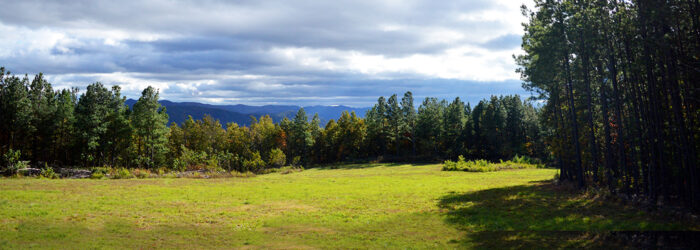Thanks to OSI and the Land & Water Conservation Fund, Virginia’s largest conservation acquisition in decades safeguards water quality in the James River & Chesapeake Bay
CHESAPEAKE BAY, VA (Nov. 18, 2019)—For two decades, Nita and David Carl enjoyed the “Grace Furnace” property in rural western Virginia as if it were their own backyard. Their daughters, and later their grandsons, splashed in the pristine streams flowing through the 5,000-acre property, leased by a local hunt club that employed David as the land’s caretaker.
“The waters are so clean; that’s rare in this day and time,” says Nita. “My family and I took extra care to make sure they stayed that way.”
When Grace Furnace was put up for sale in 2016, it was, in part, these very waters — teeming with rare species and native trout and flowing all the way to the Chesapeake Bay — that spurred conservationists to action.
Thanks to pivotal funds from the Open Space Institute (OSI), and additional support from the Chesapeake Conservancy, a celebrated local advocacy organization, the Grace Furnace property, named for its historic “pig iron” furnace, was permanently saved. It is a momentous conservation win locally for people who love the land, and for those more than 200 miles downstream, who see the project as a critical victory for water quality.
Upstream, Downstream Benefits
For watersheds everywhere, forest conservation at the headwaters is key to water quality downstream. Forests play several critical roles for stream health. They serve as natural filters and provide nutrients from leaf litter that support life up and down the food chain. Forests also regulate stream flow, lessening flooding and drought events.
And yet, as important as they are, forests now cover only about 55 percent of the Chesapeake Bay watershed. Moreover, the watershed has been losing 100 acres of forestland per day since the 1980s to development, conversion, and other threats, according to U.S. Forest Service (USFS) data.
For years, Grace Furnace had been a top conservation priority for the USFS, thanks to its 14 forested, freshwater streams that empty into the James River, and in turn the Chesapeake Bay. The Grace Furnace property flanks the Jefferson National Forest, which together with the adjacent George Washington National Forest represents one of the largest blocks of publicly owned forestland on the east coast. This made its protection even more critical.
“Properties of this size and value come around only about once every few decades,” says Joel Dunn, President and CEO of the Chesapeake Conservancy. “It was vitally important for the entire state that it be protected, not subdivided.”
Securing a Conservation Win
After the hunt club put Grace Furnace on the market, quick action was needed to protect the land. But because the Federal government was between budget cycles, the USFS was not going to be able to secure the funds on the seller’s timeline.
Moving quickly, OSI, with financial backing from the Wyss Foundation, provided a $5 million grant to purchase the property in 2016, and to hold it until the USFS could secure funding.
“When conserving land, the window can be limited and you have to act quickly,” says Dene Lee, OSI’s Land Project director.
Soon after the purchase by OSI, the project was nominated for funding by the Land & Water Conservation Fund (LWCF), the nation’s most important conservation program aimed at critically important land and water protection projects.
“The groundbreaking protection of the Grace Furnace property demonstrates in a very real way the kind of success possible when public-private partnerships mobilize around a worthy land conservation goal,” says Greg Zimmerman of the Wyss Campaign for Nature, a 10-year, $1-billion commitment by Hansjörg Wyss and the Wyss Foundation to accelerate the pace of land conservation worldwide.
Land for Critters and People
Just this fall, LWCF funds were used to officially transfer Grace Furnace from OSI to the USFS, ensuring the property’s clean waters will continue to feed the Chesapeake Bay. And its thousands of unspoiled, forested acres will be opened to the public.
One day, visitors will be able to take advantage of the incredible recreational potential of Grace Furnace, thanks to its location near Hoop Hole National Recreation Trail— a popular hiking trail flanked by rhododendron and swimming holes.
And for Nita Carl, there is relief that this local, wild playground with its critical natural resources will be around for yet another generation of her family.
“It’s been beyond gratifying watching others enjoy this land as much as we do,” she says. “And now, thanks to OSI and its partners, other peoples’ lives will be improved by the land as well.”
